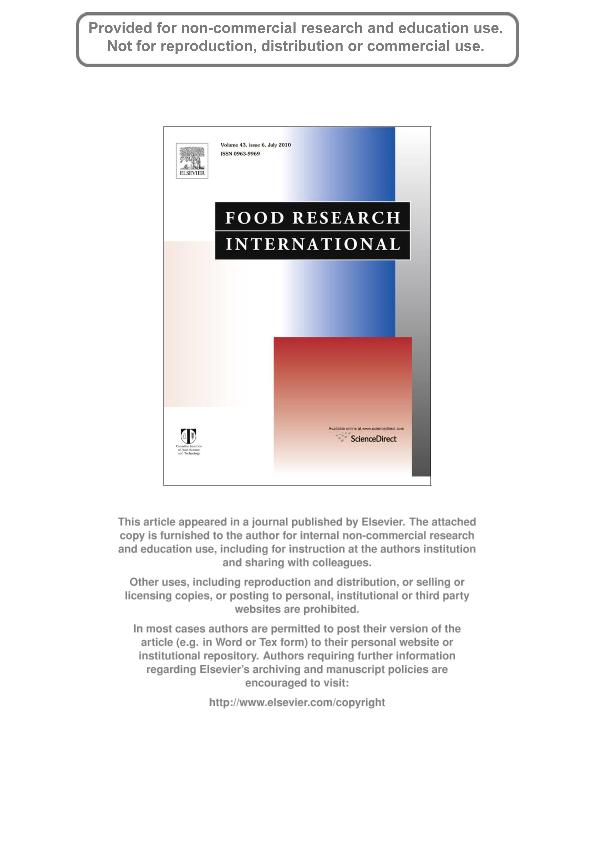Artículo
Antioxidant properties of polyphenol-rich cocoa products industrially processed
Schinella, Guillermo Raúl; Mosca, Susana Maria ; Cienfuegos Jovellanos, Elena; Pasamar, María Ángeles; Muguerza, Begoña; Ramón, Daniel; Barrios, José Luis
; Cienfuegos Jovellanos, Elena; Pasamar, María Ángeles; Muguerza, Begoña; Ramón, Daniel; Barrios, José Luis
 ; Cienfuegos Jovellanos, Elena; Pasamar, María Ángeles; Muguerza, Begoña; Ramón, Daniel; Barrios, José Luis
; Cienfuegos Jovellanos, Elena; Pasamar, María Ángeles; Muguerza, Begoña; Ramón, Daniel; Barrios, José Luis
Fecha de publicación:
07/2010
Editorial:
Elsevier Science
Revista:
Food Research International
ISSN:
0963-9969
Idioma:
Inglés
Tipo de recurso:
Artículo publicado
Clasificación temática:
Resumen
Fermentation and roasting are the main causes of polyphenol degradation during the process for obtaining cocoa products. In the present study, a process for obtaining polyphenol-rich cocoa products on an industrial scale is described. The process avoids the fermentation and roasting steps and includes a step for the inactivation of the enzyme Polyphenol Oxidase (PPO), which helps preserve the polyphenol content present in the raw cocoa bean. In addition, our study evaluates the antioxidant capacity and characterizes the flavonoid profile of the polyphenol-rich cocoa products obtained from the natural polyphenol-rich cocoa cake. Using different protocols, we have obtained three cocoa extracts with high polyphenol content, namely extracts A (167mg/g), B (374mg/g) and C (787mg/g). The scavenging capacity of the extracts was measured as their ability to bleach the stable radicals DPPH and ABTS+ while their antioxidant effect was evaluated with the FRAP assay. The results for A, B and C in the DPPH test expressed as Trolox equivalent (μmol)/mg dry weight of extract were 0.2, 1.4 and 3.0, respectively; in the ABTS test the results were 1.0, 4.7 and 9.8. The antioxidant capacity expressed as ascorbic acid equivalent (μmol)/mg dry weight of each product were 17.2, 76.1 and 207.7, respectively. The scavenging properties of cocoa powder against the superoxide anion, H2O2, HClO, and peroxynitrite were also determined. The IC50 (μg/mL) values in the hypoxanthine/xanthine oxidase test were 77.5, 12.3 and 10.3, for A, B and C, respectively, while as an HOCl scavenger the IC50 (μg/mL) values were 225.4, 73.2 and 21.5. As a peroxynitrite anion scavenger, only extract C had a relevant effect, with IC50 (μg/mL) values of 76.1 or 110.0 in the absence or presence of bicarbonate. None of the extracts tested showed activity in the hydrogen peroxide test, but B and C significantly increased the deoxyribose degradation in the absence of ascorbate. Likewise, none of the extracts inhibited the ferrous or copper chelating activity at 100μg/mL, but they inhibited the lipid peroxidation in brain homogenates and human plasma through non-enzymatic generation systems, with extract C giving the best IC50 (μg/mL) values: 17.4 and 8.1 against lipid peroxidation in brain homogenates and human plasma, respectively. In conclusion, if the extractive protocol is well characterized, defined and optimized, cocoa could constitute a source of polyphenols for enriching foods, nutraceuticals and alimentary supplements. © 2010 Elsevier Ltd.
Palabras clave:
Antioxidant
,
Cocoa
,
Polyphenols
,
Theobroma Cacao
Archivos asociados
Licencia
Identificadores
Colecciones
Articulos(CIC)
Articulos de CENTRO DE INVEST.CARDIOVASCULARES (I)
Articulos de CENTRO DE INVEST.CARDIOVASCULARES (I)
Citación
Schinella, Guillermo Raúl; Mosca, Susana Maria; Cienfuegos Jovellanos, Elena; Pasamar, María Ángeles; Muguerza, Begoña; et al.; Antioxidant properties of polyphenol-rich cocoa products industrially processed; Elsevier Science; Food Research International; 43; 6; 7-2010; 1614-1623
Compartir
Altmétricas



